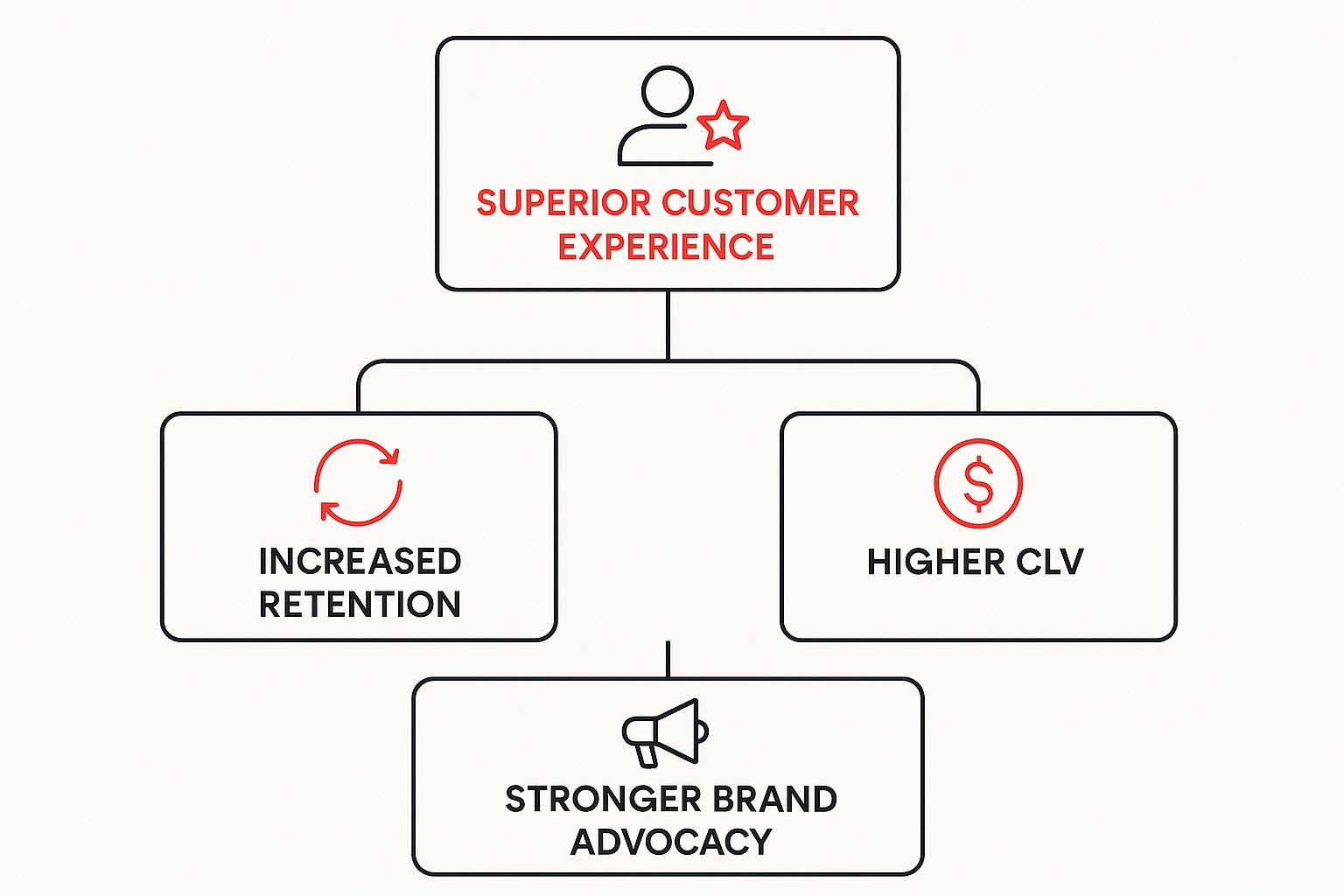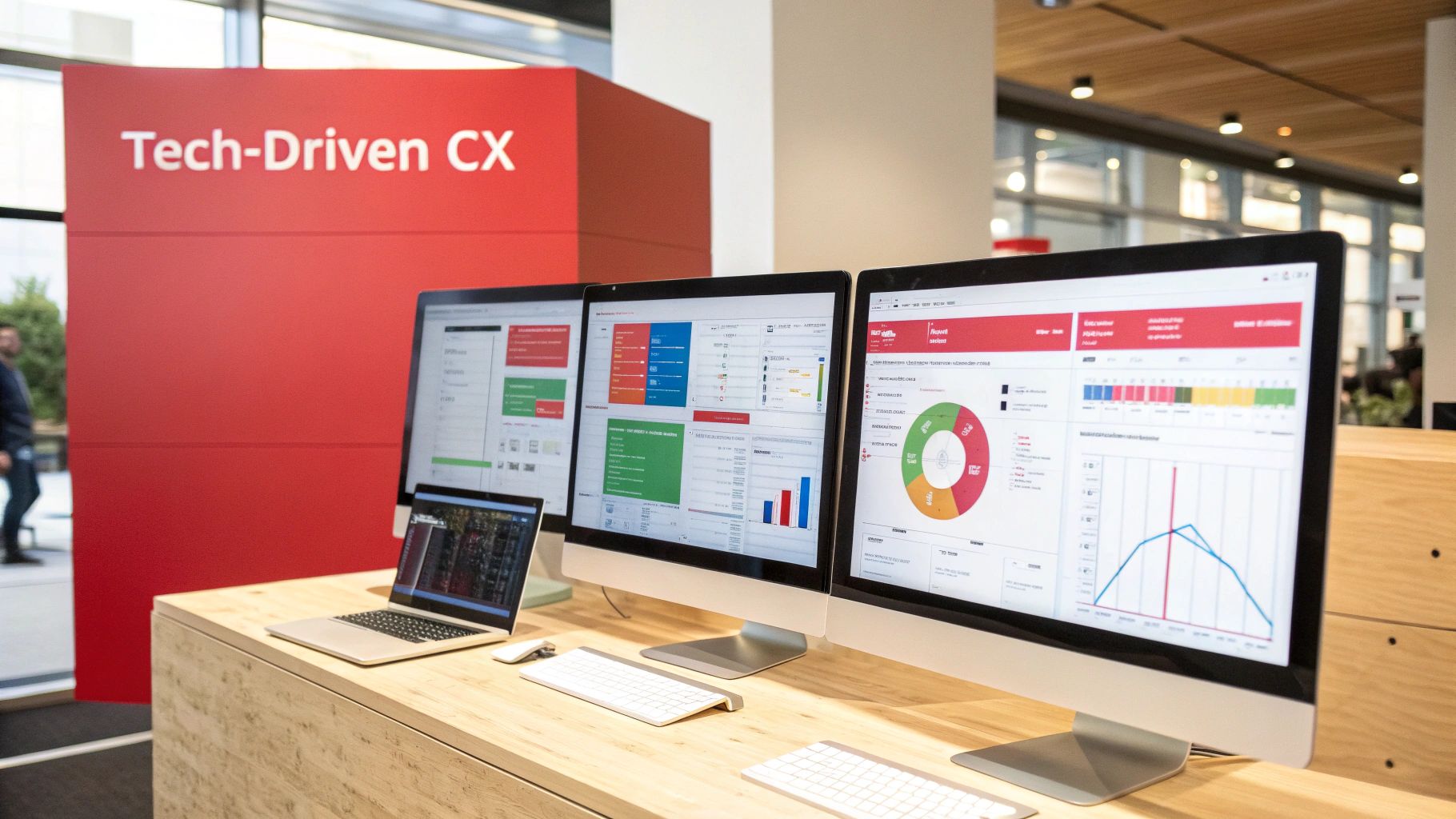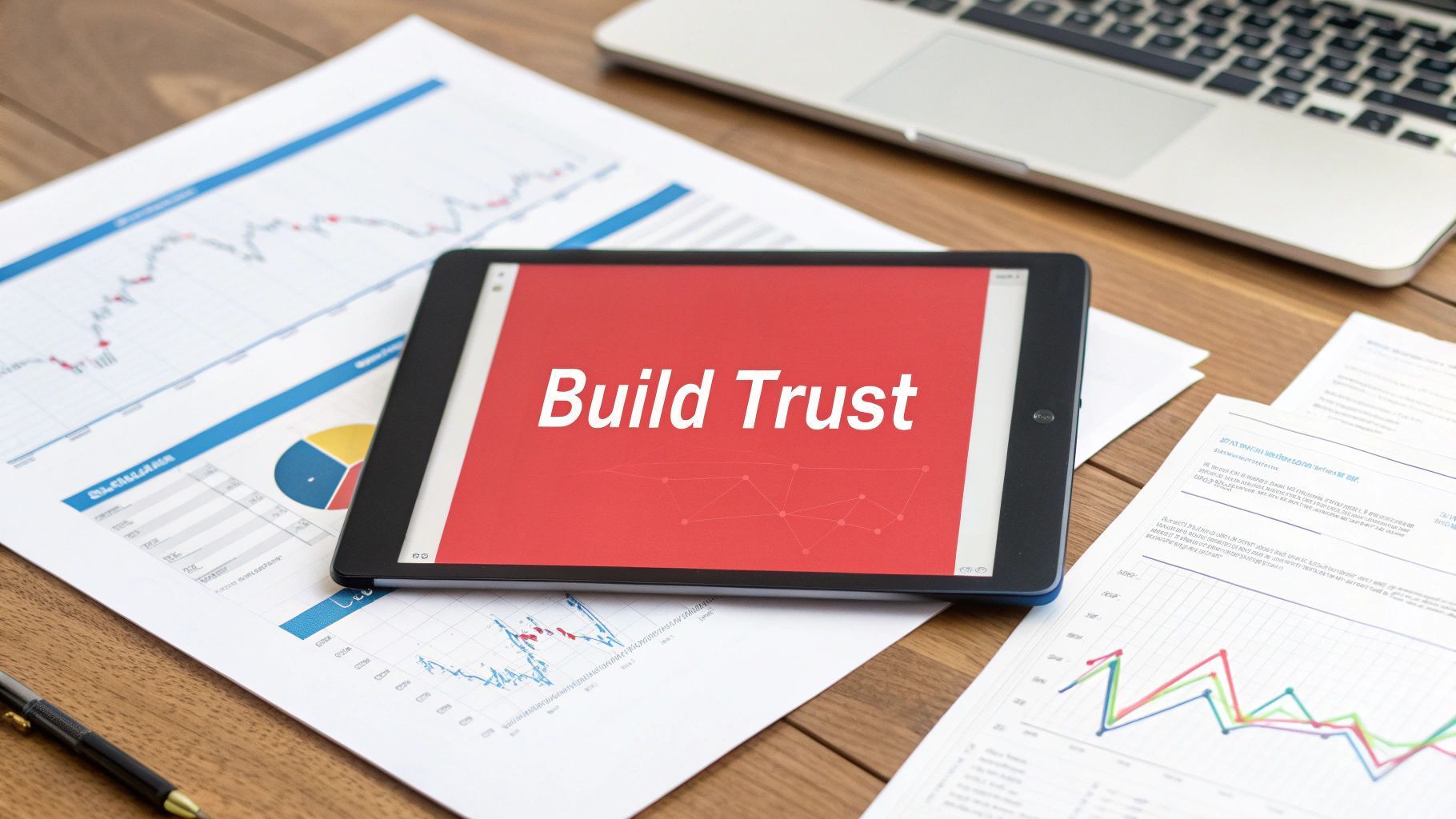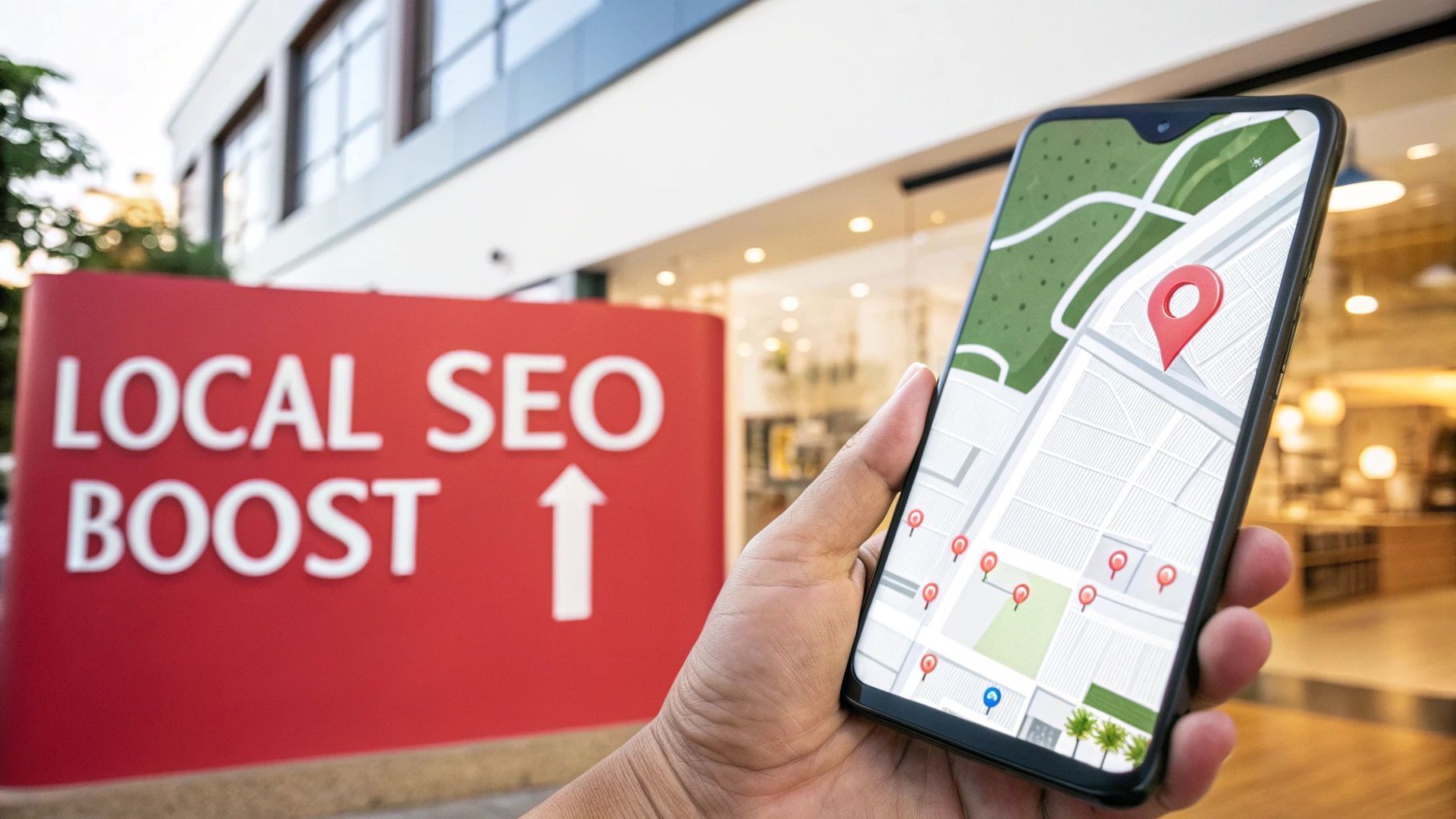Customer Experience Optimisation: Your Ultimate Guide
Ever had one of those moments with a company that just worked ? The website was a breeze to use, the online chat was actually helpful, the purchase was simple, and the follow-up email made you smile. That feeling does not happen by accident. It is the result of something we call customer experience optimisation (CXO) – the art of intentionally designing every single interaction someone has with your brand to be as good as it can possibly be.
What Exactly Is Customer Experience Optimisation?
Think of your business as a restaurant. CXO is not just about how good the food is. It is the whole package: how easy it was to book online, the welcome you get at the door, the atmosphere, the service, and even how simple it is to pay the bill. That is customer experience optimisation in a nutshell. It is the ongoing process of fine-tuning every point of contact a person has with your business. It is never a one-and-done job.
This is worlds away from old-school customer service, which was mostly about reacting to problems after they happened. CXO is all about being proactive. The goal is to design a customer journey so smooth and intuitive that most problems never even get a chance to surface. It is about creating an experience that feels completely effortless.
From Individual Touchpoints to a Cohesive Journey
One of the biggest mistakes businesses make is seeing customer interactions as separate, isolated events. A customer might browse your website, then talk to a salesperson, and later contact your support team. CXO is about weaving these disconnected moments into a single, seamless story.
Customer experience optimisation is about ensuring the story your brand tells is consistent, positive, and memorable at every single chapter of the customer's journey, from their first impression to their long-term loyalty.
To really get what this means, you have to walk in your customer's shoes. This is where tools like customer journey mapping software come in, helping you visualise every step they take. By mapping out this entire path, you can instantly spot the bumps in the road and find golden opportunities to make things better.
It all boils down to a few key activities working together:
- Data Collection: Actively gathering feedback from surveys, reviews, and website analytics to figure out what customers actually want and where they are getting stuck.
- Process Refinement: Making things like your checkout, returns process, or support system as ridiculously simple as possible.
- Personalisation: Using what you know about your customers to offer recommendations and messages that feel relevant and show you are paying attention.
- Team Empowerment: Making sure everyone, from marketing to the warehouse, is on the same page and has what they need to deliver a consistently brilliant experience.
Why It Is More Than Just a Buzzword
Let us be honest, in today’s market, almost any product or price can be copied. A genuinely fantastic customer experience, however, is much harder for your competitors to replicate. It builds a real emotional connection, turning happy customers into your most powerful marketing asset: loyal brand advocates.
This focus on the entire journey is what transforms a one-off transaction into a lasting relationship, giving modern UK businesses their ultimate competitive edge.
Why Investing in CX Is a Game Changer
In a marketplace flooded with options, competing on product features or price is a fast track to the bottom. Your rivals can copy your latest update or slash their prices tomorrow. It is a temporary edge, at best. But a genuinely brilliant customer experience? That is much, much harder to replicate.
It is the one thing that can truly set your brand apart for the long haul.
This is exactly why customer experience optimisation (CXO) is not just another business expense; it is a powerful engine for growth. Think of it as a strategic investment that pays dividends in loyalty, reputation, and ultimately, revenue. When you nail those customer interactions, you stop being just a transaction and start building real, lasting relationships.
The Direct Link to Business Growth
A smart CX strategy has a direct, measurable impact on your bottom line. It creates a positive feedback loop where happy customers fuel sustainable growth, meaning you do not have to rely so heavily on costly marketing campaigns to find new business. The whole idea is to create an experience so good that customers not only stay, but they also go out and tell others about you.
A positive customer journey is the most reliable path to higher retention, increased lifetime value, and a stronger brand reputation that money simply cannot buy.
Delighted customers do more than just buy from you again. They become your most passionate and effective marketers through genuine, word-of-mouth recommendations. This kind of organic advocacy is incredibly powerful because it comes from a trusted source, turning your CX efforts into a genuine driver of new business.
The infographic below shows how a superior customer experience builds directly towards a stronger, more resilient business.

As you can see, it all starts with the customer’s experience. Get that right, and you unlock the loyalty that turns customers into powerful brand advocates.
Turning Experience into Revenue
Putting money into the customer experience is no longer a "nice-to-have"—it is a commercial necessity, especially here in the UK. In fact, for many people, the quality of the experience now outweighs traditional factors like product features or even price.
The data backs this up. A recent UK survey revealed that 51% of respondents now believe customer experience is more important than product quality and price when deciding where to spend their money. If that does not show how central the journey has become, nothing will.
On top of that, when UK businesses were asked about their main goals, 65% put ‘increasing customer retention rates’ at the top of their list. The focus is clearly on loyalty. You can dig into these findings yourself in the CX Decision-Makers' Guide 2024-25.
And this focus on retention is just smart business. We all know it can cost five times more to win a new customer than to keep an existing one. By optimising your customer experience, you are hitting two critical goals at once:
- You increase Customer Lifetime Value (CLV) by encouraging people to come back again and again, building loyalty over time.
- You reduce customer churn , which stops revenue from leaking out of your business and makes your financial foundation much more stable.
Ultimately, investing in CX is about building a business that is not just profitable today, but is also resilient and respected for years to come. It is a strategic choice to compete on real value and human relationships, not just on price tags.
Core Strategies for Optimising Your Customer Experience

Knowing that customer experience optimisation is important is one thing. Actually making it happen is another game entirely. To get real results, you need a clear, actionable plan built on a few core strategies that all work together. These are the pillars that turn good intentions into tangible improvements.
It all starts with a simple goal: to genuinely understand who your customers are and what they need from you. Nail that, and you can build experiences that feel human and make people feel seen.
Develop Detailed Customer Personas and Journey Maps
Before you can fix the customer experience, you have to live it. You need to see the world through their eyes, and that means going way beyond basic demographics. The first step is building rich, detailed customer personas – fictional characters that represent your ideal customers, complete with their goals, motivations, and frustrations.
Once you know who they are, you need to map their entire journey with your brand. A customer journey map is a visual blueprint of every single touchpoint, from the moment they first hear about you to the support they get long after a purchase. This process is absolute gold for spotting friction points and uncovering hidden opportunities to make someone's day.
By walking in your customer's shoes, you stop guessing what they want and start seeing the journey through their eyes. This shift in perspective is the first and most crucial step in any meaningful customer experience optimisation effort.
This detailed understanding becomes the bedrock for everything else you do, making sure your efforts are aimed at what truly matters.
Actively Gather and Act On Customer Feedback
You cannot fix problems you do not know exist. That is why a solid feedback system is non-negotiable for continuous improvement. Think of it as the pulse of your customer experience. This is not about passively waiting for complaints to roll in; it is about proactively asking for opinions.
There are a few tried-and-tested ways to gather this vital intel:
- Net Promoter Score (NPS): This asks a simple question: "How likely are you to recommend our business to a friend?" It is a brilliant measure of overall loyalty.
- Customer Satisfaction (CSAT): Usually asked right after a specific interaction, like a support call, this gauges short-term happiness with a single touchpoint.
- Customer Effort Score (CES): This one checks how easy it was for a customer to get their problem solved – a huge indicator of a smooth, friction-free experience.
But remember, collecting data is only half the job. The real magic happens when you analyse the feedback, spot the patterns, and act on the insights to make concrete changes. This creates a powerful loop where customers see their feedback actually leads to a better experience.
Embrace Meaningful Personalisation
In a world full of generic marketing and automated replies, personalisation makes your brand feel human. We are talking about more than just slotting a first name into an email. Real personalisation uses data to deliver relevant content, offers, and experiences that are genuinely helpful.
For example, an e-commerce site could recommend products based on past purchases, or a software company could tailor its advice based on how a customer actually uses its platform. The goal is to be helpful, not creepy. When you get it right, it shows you are paying attention. If you want to dive deeper into making this work, you can explore the power of personalisation in digital marketing in our detailed guide.
This focus on tailored experiences is already paying off. The latest UK Customer Satisfaction Index (UKCSI) hit a score of 77.3 out of 100 , its highest point since January 2023. The report noted this jump was partly down to more businesses offering a personalised response that made customers feel genuinely cared for.
Empower Your Frontline Teams
Never, ever underestimate the human element. Your customer service agents, salespeople, and support teams are the face and voice of your brand. Giving them the power to do their jobs well is one of the most powerful customer experience optimisation strategies you have.
This means giving them the right training, the right tools, and the autonomy to actually solve customer problems without jumping through hoops. When your team is stuck reading from rigid scripts or needs a manager's approval for every little thing, it just creates delays and frustration for everyone.
An empowered team, on the other hand, can turn a bad situation into a great one, building incredible trust and loyalty along the way. For a closer look at practical steps, check out these effective strategies to improve customer experience.
To pull all this together, here is a quick summary of how these strategies translate into real-world business impact.
Key CXO Strategies And Their Business Impact
| Strategy | Primary Action | Expected Business Impact |
|---|---|---|
| Persona & Journey Mapping | Visually map every customer touchpoint and pain point. | Identifies friction, reduces churn, and uncovers innovation opportunities. |
| Feedback Collection | Systematically gather and analyse NPS, CSAT, and CES data. | Drives continuous improvement and shows customers you are listening. |
| Meaningful Personalisation | Use customer data to deliver relevant and timely interactions. | Increases engagement, conversion rates, and overall customer loyalty. |
| Team Empowerment | Provide frontline staff with autonomy, training, and better tools. | Improves first-contact resolution, boosts morale, and enhances brand perception. |
Ultimately, these strategies are not just separate tasks on a checklist. They are interconnected parts of a bigger commitment to putting your customer at the absolute centre of your business.
Using Technology to Power Your CX Strategy

A great strategy for customer experience optimisation needs a powerful engine to bring it to life. Today, that engine is technology.
The right tech stack does not just make things more efficient; it unlocks the ability to deliver seamless, personalised experiences at a scale you could never manage manually. Think of it as the essential backbone of any modern CX programme.
Your technology is your team’s superpower. The right tools amplify their ability to create memorable interactions, freeing them from repetitive tasks so they can focus on complex, high-empathy issues where the human touch really matters. This blend of smart tech and skilled people is what separates good customer experiences from genuinely great ones.
The Central Nervous System: Your CRM
At the very heart of any CX tech stack is the Customer Relationship Management (CRM) system. It acts as the central memory bank for every single customer interaction, storing everything from purchase history and support tickets to personal preferences. Without a CRM, you are basically starting from scratch with every conversation—a surefire recipe for frustration.
A well-oiled CRM ensures that when a customer gets in touch, your team already knows who they are, what they have bought, and what problems they have had before. This single source of truth creates a consistent and informed experience across all departments, from sales to support.
Your CRM system is the foundation of personalised customer experience optimisation. It transforms isolated data points into a coherent customer story, empowering your team to provide context-aware and genuinely helpful service every time.
By centralising this information, you equip your team to anticipate needs rather than just reacting to problems. And that proactive approach is fundamental to building lasting customer relationships.
Uncovering Insights with Analytics Tools
While a CRM stores what you know , analytics tools help you discover what you do not. These platforms are like detectives for your customer data. They sift through website clicks, app usage, and purchasing behaviours to uncover hidden patterns and trends.
They answer critical questions like, “Where are customers getting stuck in our checkout process?” or “Which features do our most loyal users engage with the most?”
This data-driven insight is crucial for making smart decisions. Instead of guessing where to invest your resources, you can pinpoint the exact friction points in the customer journey and prioritise improvements that will have the biggest impact.
For example, analytics might reveal that a significant number of mobile users abandon their carts on a specific page. Armed with that knowledge, you can investigate and fix the issue, directly improving the experience and boosting conversions. This is customer experience optimisation in its most practical form.
The Rise of Artificial Intelligence in CX
Artificial intelligence (AI) is rapidly becoming a cornerstone of modern CX strategy, especially here in the UK. AI-powered tools like chatbots can provide instant, 24/7 support for common queries, resolving simple issues on the spot and freeing up human agents to handle more complex cases.
Of course, the potential of AI extends far beyond just chatbots. You can learn more about its broader applications in our guide on how artificial intelligence is revolutionising digital marketing.
A major shift in UK customer experience optimisation is the rapid adoption of AI. It is predicted that by 2025, 80% of customer service organisations in the UK will use generative AI to transform agent productivity and customer interactions. However, this shift is not without its challenges. Many businesses struggle to connect different AI models or focus too heavily on personalisation at the expense of nailing the fundamentals. You can discover more insights about this evolving CX landscape in a recent KPMG report.
The Challenge of Legacy Systems
Finally, it is vital to address a common roadblock: outdated technology. Legacy systems—old software or hardware that is no longer efficient—can create significant friction. If your different systems cannot communicate with each other, you create information silos that lead to a disjointed and frustrating customer journey.
Integrating modern tools with a smart strategy is the key. When your technology works together seamlessly, it empowers your team, streamlines processes, and ultimately allows you to deliver the exceptional experiences that build loyalty and drive growth.
How to Measure the Success of Your CX Efforts
Trying to optimise your customer journey without measuring anything is like driving with your eyes closed. You might feel like you are moving forward, but you have no idea if you are actually on the right road. Real customer experience optimisation runs on data. You need the right metrics to tell you what is working and what is not.
But it is about more than just numbers on a screen. It is about drawing a straight line from a specific CX improvement to a real business result. This gives you the proof you need to get buy-in, justify the investment, and build momentum for more improvements.
The trick is to mix the quantitative (the what ) with the qualitative (the why ) to get the full story.
The Big Three Survey Metrics
When it comes to getting a direct pulse on how customers feel, a few core metrics have become the go-to for a reason. They are simple, powerful, and give you a reliable snapshot of sentiment at different points in their journey.
These are the essential survey-based metrics you absolutely need to be tracking:
- Net Promoter Score (NPS): This is all about long-term loyalty. It boils down to one simple question: "On a scale of 0-10 , how likely are you to recommend our company to a friend or colleague?" This splits your customers into Promoters, Passives, and Detractors, giving you a single score that shows how many people are out there championing your brand.
- Customer Satisfaction (CSAT): CSAT is more of an in-the-moment check-up. It measures how happy someone is with a specific interaction, like a support chat or a recent delivery. The question is usually something like, "How satisfied were you with your recent experience?" It is brilliant for spotting problems at individual touchpoints.
- Customer Effort Score (CES): This one has gained a lot of ground recently. It measures how easy it was for a customer to get something done, whether that is getting an issue fixed or making a purchase. A low-effort experience is a massive indicator of future loyalty, making CES a vital tool for finding and eliminating friction.
While these scores are invaluable, they are just one piece of the puzzle. The real gold is often in the follow-up question: "Why did you give that score?" This is where a simple number turns into feedback you can actually use.
To give you a clearer picture, here is a quick breakdown of how these metrics stack up against each other.
Comparing Key Customer Experience Metrics
| Metric | What It Measures | Typical Question |
|---|---|---|
| Net Promoter Score (NPS) | Overall brand loyalty and advocacy. | "How likely are you to recommend us to a friend?" |
| Customer Satisfaction (CSAT) | Short-term happiness with a specific interaction. | "How satisfied were you with your recent purchase?" |
| Customer Effort Score (CES) | The ease of a customer's experience. | "How easy was it to get your issue resolved?" |
Each metric gives you a different lens through which to view your customer’s experience. Using them together provides a much more rounded view than relying on just one.
Looking Beyond the Surveys
While numbers tell you what happened, it is the qualitative feedback that tells you the story behind the score. To really understand the complete picture, you have to dig into the comments, reviews, and conversations your customers are having about you. This is where you find the emotional context that a survey just cannot capture.
Reading through support tickets, live chat logs, and online reviews can reveal the same pain points popping up again and again—or those little moments of delight a simple score would completely miss.
For instance, you might have a high CSAT score for your support team, but notice a recurring theme in the comments about a confusing checkout page. That tells you exactly where your next customer experience optimisation efforts need to go.
Connecting CX to Business KPIs
To really prove the value of your CX work, you have to connect it to the high-level numbers that the rest of the business—and especially the board—cares about. This means tying your NPS or CSAT scores directly to financial results and operational efficiency.
Here are two of the most important business-level KPIs to focus on:
- Customer Churn Rate: This is the percentage of customers who walk away over a certain period. A high churn rate is a flashing red light for a poor experience. Showing a reduction in churn is one of the most powerful ways to prove the financial return on your CX investment.
- Customer Lifetime Value (CLV): CLV is a prediction of the total amount of money a single customer is likely to spend with you. When you improve the experience, you boost loyalty and encourage repeat business, which directly pushes up the average CLV. It is the ultimate proof that your CX efforts are profitable in the long run.
Ultimately, better experiences can also improve website conversion rates for UK businesses , turning more first-time visitors into loyal, high-value customers.
By tracking this blend of survey data, real-world feedback, and hard business numbers, you create a powerful measurement system. It does not just help you improve the customer journey—it proves its direct impact on your company's bottom line.
Kicking Off Your CXO Journey
Here is the single most important thing to grasp: customer experience optimisation is not a project with an end date. It is not like building a house where you finish the job and walk away. Think of it more like tending a garden—it needs constant attention, care, and adapting to ever-changing conditions. It is a continuous loop of improvement.
This whole journey is built on the core ideas we have covered. It all starts with truly getting to know your customer, then applying smart strategies, and is powered by using the right tech and measuring what actually matters. Each piece of the puzzle supports the others, creating an ongoing cycle.
Building Momentum from Day One
It is easy to look at the mountain of work and feel overwhelmed, but you do not need to fix everything at once. The best way forward is to start small and build up speed.
Pinpoint the most critical touchpoints in your customer's journey. Find that one big point of friction—the one that triggers the most complaints or causes people to leave—and make solving it your first mission.
The goal is to build momentum and foster a company-wide culture where every single team member feels they own a piece of the customer experience. Small, visible wins are the fastest way to get everyone on board.
This approach delivers real results, fast. That makes it easier to justify more investment and gets the whole organisation excited about what is next.
Creating a Customer-First Culture
At the end of the day, true customer experience optimisation has to become part of your company’s DNA. It is a shared mindset, not just a task for one department.
To get there, you need to build a culture where everyone, no matter their role, understands how they affect the customer. This means:
- Sharing Feedback Everywhere: Make sure customer insights—the good, the bad, and the ugly—are shared across all teams, not locked away in a marketing or support silo.
- Celebrating CX Wins: When an employee goes the extra mile to create a brilliant moment for a customer, shout about it. Recognise them publicly.
- Empowering Your People: Give your teams the tools and the freedom to make on-the-spot decisions that help the customer.
You now have the framework to start this journey. By starting small and weaving these principles into your culture, you can build a brand that people do not just buy from, but one they will shout about from the rooftops.
Frequently Asked Questions
Diving into customer experience optimisation often brings up a few questions. We have answered the most common ones here to give you the clarity you need to get started.
How Is CXO Different from Customer Service?
Think of customer service as a reaction. It is what happens when a customer hits a snag and reaches out for help. It is absolutely vital, but it is just one piece of the much bigger picture.
Customer experience optimisation (CXO) , on the other hand, is proactive. It is about designing the entire journey—from the first time someone hears about you to the support they get years later—to be as smooth and intuitive as possible. The real goal of CXO is to stop problems from ever happening in the first place.
Where Is the Best Place to Start with CXO?
It is easy to feel overwhelmed, so the best advice is to start small and aim for maximum impact. Do not try to fix everything all at once.
The best first step is to map out your customer journey and pinpoint the single biggest point of friction. Maybe it is a clunky checkout process, a slow-loading webpage, or a complaint your support team hears over and over again.
Tackling the most significant pain point first will deliver the most noticeable improvement for your customers and build momentum within your organisation to keep the process going.
By securing a quick win, you make a tangible difference and prove the value of your efforts straight away.
What Is the Most Important Metric to Track?
There is no single magic metric. The smartest approach is to use a combination to get a complete, well-rounded view of performance. But if you have to start somewhere, the Net Promoter Score (NPS) is a solid foundation.
NPS is powerful because it measures loyalty and the odds of a customer recommending you to others—a strong indicator of your brand's long-term health. While other metrics are useful, NPS gives you that high-level snapshot of your customer relationships.
Ultimately, the right mix of metrics comes down to your specific goals, but a balanced scorecard usually includes:
- Net Promoter Score (NPS) for loyalty.
- Customer Satisfaction (CSAT) for feedback on specific interactions.
- Customer Effort Score (CES) to spot and remove friction.
How Often Should I Be Optimising the Customer Experience?
Customer experience optimisation is not a one-and-done project; it is a continuous process. Customer expectations are always on the move—what delighted someone yesterday is simply the standard today.
You should always be gathering feedback, analysing data, and looking for small, steady improvements you can make. Treat it like any other core business function, like marketing or sales, not a task with a clear beginning and end. This commitment to constant refinement is what separates good companies from the truly great ones.
Ready to build a brand that customers love and advocate for? At Superhub , we specialise in creating marketing strategies that place your customer at the centre of everything. Get in touch with our expert team to discover how we can help you turn great experiences into sustainable growth.





